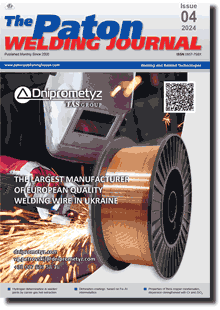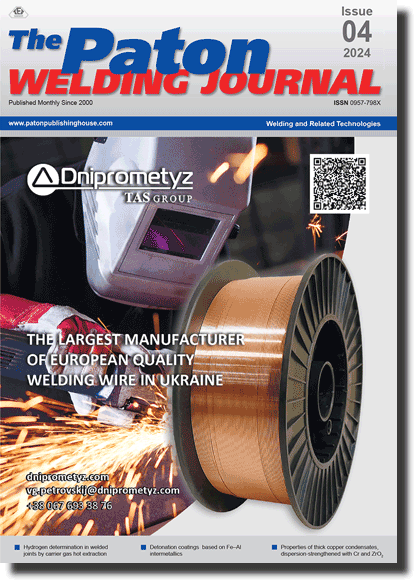| 2024 №04 (01) |
DOI of Article 10.37434/tpwj2024.04.02 |
2024 №04 (03) |

The Paton Welding Journal, 2024, #4, 11-17 pages
Computational evaluation of the influence of the thickness of welded joints of AMg6 alloy on their stress-strain state after electrodynamic treatment in the process of welding
L.M. Lobanov1, M.O. Pashchyn1, O.L. Mikhoduj1, N.L. Todorovych1, Yu.M. Sydorenko2, P.R. Ustymenko2
1E.O. Paton Electric Welding Institute of the NASU. 11 Kazymyr Malevych Str., 03150, Kyiv, Ukraine. E-mail: svarka2000@ukr.net2NTUU «Kyiv Igor Sikorsky Polytechnic Institute. 37 Beresteisky Ave., 03056, Kyiv.
Abstract
A calculated evaluation of the efficiency of electrodynamic treatment (EDT) effect on the stress state of butt-welded joints of paltes made of aluminium AMg6 alloy with an increase in their thickness δ was carried out. Mathematical modelling of the kinetics and residual stress states of butt-welded joints δ = 2, 4 and 8 mm as a result of their EDT at different values of the temperature T of the plates, at which the treatment was carried out was performed. The value of the vertical velocity V0 of the indenter electrode (EDT tool) was taken as V0 =5 m/s, which corresponds to the modern electrophysical characteristics of the equipment for EDT. The T value was set, reflecting the conditions of EDT after welding (T = 20°C) and during fusion welding (T = 150 and 300°C). The problem was solved in a threedimensional formulation using the ANSYS program. The conditions for the formation of stresses in the plates at EDT after and during welding were determined by the mechanical characteristics of the AMg6 alloy at temperatures T = 20, 150, and 300°C without taking cooling into account. The results of the calculation of kinetics and residual stresses in welded joints are presented. It is shown that for a value of Т = 150°С, EDT provides the most optimal residual stress states of the plates in the entire experimental range δ. It was proven that EDT in the welding process (at T = 150°С) is more efficient compared to EDT of metal after cooling (T = 20°С). It was established that at EDT of welded joints δ = 2 – 4 mm, residual compressive stresses are formed over the entire thickness of the plates, the values of which are close to the yield strength of the AMg6 alloy. At EDT of welded joints δ = 8 mm, residual compressive stresses are formed on the outer surface of the plates, and on the back side – tensile ones. 11 Ref., 2 Tabl., 5 Fig.
Keywords: electrodynamic treatment, residual welding stresses, aluminium alloy, electric current pulse, shock interaction, finite-element model, electrode-indenter, theory of elastic-plastic flow, fusion welding
Received: 13.11.2023
Received in revised form: 19.02.2024
Accepted: 07.05.2024
References
1. Madi, Y., Besson, J. (2014) Effect of residual stresses on brittle fracture. Mat. ECRS-9. UTT, Troyes, Franse.2. (2022) Welding and technical diagnostics for the recovery of the economy of Ukraine: Abstracts of reports science conf. Kyiv: International Association «Welding».
3. Lobanov, L.M., Pashchin, N.A., Mikhodui, O.L., Sidorenko, Y.M. (2018) Electric Pulse Component Effect on the Stress State of AMg6 Aluminum Alloy Welded Joints Under Electrodynamic Treatment. Strength of Materials, 50(2), 246- 253. https://doi.org/10.1007/s11223-017-9862-8
4. Sydorenko, Y.M., Pashchin, М.О., Mykhodui, O.L. et al.(2020) Effect of Pulse Current on Residual Stresses in AMg6 Aluminum Alloy in Electrodynamic Treatment. Strength of Materials, 52(5), 731-737. https://doi.org/10.1007/s11223-020-00226-2
5. Conrad, H., Sprecher, A. (1989) The electroplastic effect in metals. Elsevier Science Publishers B.V., Dislocations in Solids Ed. by F.R.N. Nabarro, 500-529.
6. Shao, Quan, Kang, Jiajie, Xing, Zhiguo et al. (2019) Effect of pulsed magnetic field treatment on the residual stress of 20Cr2Ni4A steel. J. of Magnetizm and Magnetic Materials, 476, 218-224. https://doi.org/10.1016/j.jmmm.2018.12.105
7. Stepanov, G.V., Babutskii, A.I., Mameev, I.A. (2004) High-Density Pulse Current-Induced Unsteady Stress-Strain State in a Long Rod. Strength of Materials 36, 377-381. https://doi.org/10.1023/B:STOM.0000041538.10830.34
8. Lobanov, L.M., Pashchyn, M.O., Mykhodui, O.L. et al. (2022) Stress-Strain State of Welded Joints of AMg6 Alloy after Electrodynamic Treatment During Welding. Strength of Materials, 54, 6, 983-996. https://doi.org/10.1007/s11223-023-00474-y
9. Lobanov, L.M., Pashchin, N.A., Mikhodui, O.L. (2012) Efficiency of electrodynamic treatment of welded joints of AMg6 alloy of different thickness. The Paton Welding J., 3, 6-10. https://doi.org/10.37434/tpwj2022.04.01
10. http://www.ansys.com/.
11. Masubuchi, K. (1980) Analisis of welded structures. Pergamon Press, Oxford, United Kingdom.
Suggested Citation
L.M. Lobanov, M.O. Pashchyn, O.L. Mikhoduj, N.L. Todorovych, Yu.M. Sydorenko, P.R. Ustymenko (2024) Computational evaluation of the influence of the thickness of welded joints of AMg6 alloy on their stress-strain state after electrodynamic treatment in the process of welding. The Paton Welding J., 04, 11-17.To order the electronic version of the paper:
L.M. Lobanov, M.O. Pashchyn, O.L. Mikhoduj, N.L. Todorovych, Yu.M. Sydorenko, P.R. UstymenkoComputational evaluation of the influence of the thickness of welded joints of AMg6 alloy on their stress-strain state after electrodynamic treatment in the process of welding
The Paton Welding Journal №04 2024 p.11-17
The cost of article (pdf): 13 $, 12 €, 280 UAH (1 copy. )
fill in the form below:
The cost of subscription/purchase order journals or individual articles
| Journal/Currency | Annual Set | 1 issue printed |
1 issue |
one article |
| TPWJ/USD | 384 $ | 32 $ | 26 $ | 13 $ |
| TPWJ/EUR | 348 € | 29 € | 24 € | 12 € |
| TPWJ/UAH | 7200 UAH | 600 UAH | 600 UAH | 280 UAH |
| AS/UAH | 1800 UAH | 300 UAH | 300 UAH | 150 UAH |
| AS/USD | 192 $ | 32 $ | 26 $ | 13 $ |
| AS/EUR | 180 € | 30 € | 25 € | 12 € |
| SEM/UAH | 1200 UAH | 300 UAH | 300 UAH | 150 UAH |
| SEM/USD | 128 $ | 32 $ | 26 $ | 13 $ |
| SEM/EUR | 120 € | 30 € | 25 € | 12 € |
| TDNK/UAH | 1200 UAH | 300 UAH | 300 UAH | 150 UAH |
| TDNK/USD | 128 $ | 32 $ | 26 $ | 13 $ |
| TDNK/EUR | 120 € | 30 € | 25 € | 15 € |
AS = «Automatic Welding» - 6 issues per year;
TPWJ = «PATON WELDING JOURNAL» - 12 issues per year;
SEM = «Electrometallurgy Today» - 4 issues per year;
TDNK = «Technical Diagnostics and Non-Destructive Testing» - 4 issues per year.


